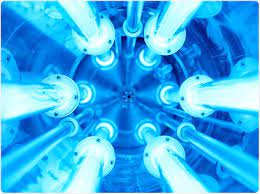Ultraviolet disinfection (UV Sterilization) of water consists of a purely physical, chemical- free process. UV-C radiation attacks the vital DNA of the bacteria directly. The bacteria lose their reproductive capability and are destroyed.
Even parasites such as Cryptosporidia or Giardia, which are extremely resistant to chemical disinfectants, are efficiently reduced (Harm, 1980).
UV can also be used to remove chlorine and chloramine species from water; this process is called photolysis, and requires a higher dose than normal disinfection. The sterilised micro-organisms are not removed from the water.
UV disinfection does not remove dissolved organics, inorganic compounds or particles in the water. However, UV- oxidation processes can be used to simultaneously destroy trace chemical contaminants and provide high-level disinfection, such as the world’s largest indirect potable reuse plant in Orange County, California.
That title will soon be taken by New York which is set to open the Catskill-Delaware Water Ultraviolet Disinfection Facility, by the end of 2012. A total of 56 energy-efficient UV reactors will be installed to treat 2.2 billion US gallons (8,300,000 m3) a day to serve New York City (Wolfe, 1990).
Read Also : Industrial Waste-water Treatment Trickle Filters
UV disinfection leaves no taint, chemicals or residues in the treated water. Disinfection using UV light is quick and clean. The UV Tube is a design concept for providing inexpensive water disinfection to people in poor countries.
The concept is based the ability of ultraviolet light to kill infectious agents by disrupting their DNA. It was initially developed under an “open source” model at the Renewable and Appropriate Energy Laboratory at the University of California, Berkeley.
The form and composition of the UV Tube can vary depending on the resources available and the preferences of those building and using the device.
However, certain geometric parameters must be maintained to ensure consistent performance. Several different versions of the UV Tube are currently being used in multiple locations in Mexico and Sri Lanka.
Water sterilization kits


Read Also: Signs of Ruminant Animals on Heat

